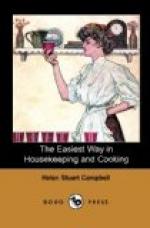To nourish this body, then, demands many elements; and to study these has been the joint work of chemists and physiologists, till at last every constituent of the body is known and classified. Many as these constituents are, they are all resolved into the simple elements, oxygen, hydrogen, nitrogen, and carbon, while a little sulphur, a little phosphorus, lime, chlorine, sodium, &c., are added.
FLESH and BLOOD are composed of water, fat, fibrine, albumen, gelatine, and the compounds of lime, phosphorus, soda, potash, magnesia, iron, &c.
BONE contains cartilage, gelatine, fat, and the salts of lime, magnesia, soda, &c., in combination with phosphoric and other acids.
CARTILAGE consists of chondrine, a substance somewhat like gelatine, and contains also the salts of sulphur, lime, soda, potash, phosphorus, magnesia, and iron.
BILE is made up of water, fat, resin, sugar, cholesterine, some fatty acids, and the salts of potash, iron, and soda.
THE BRAIN is made up of water, albumen, fat, phosphoric acid, osmazone, and salts.
THE LIVER unites water, fat, and albumen, with phosphoric and other acids, and lime, iron, soda, and potash.
THE LUNGS are formed of two substances: one like gelatine; another of the nature of caseine and albumen, fibrine, cholesterine, iron, water, soda, and various fatty and organic acids.
How these varied elements are held together, even science with all its deep searchings has never told. No man, by whatsoever combination of elements, has ever made a living plant, much less a living animal. No better comparison has ever been given than that of Youmans, who makes a table of the analogies between the human body and the steam-engine, which I give as it stands.
ANALOGIES OF THE STEAM-ENGINE AND THE LIVING BODY.
The Steam Engine in Action takes:
1. Fuel: coal and wood, both combustible.
2. Water for evaporation.
3. Air for combustion.
And Produces:
4. A steady boiling heat of 212 deg. by quick combustion.




